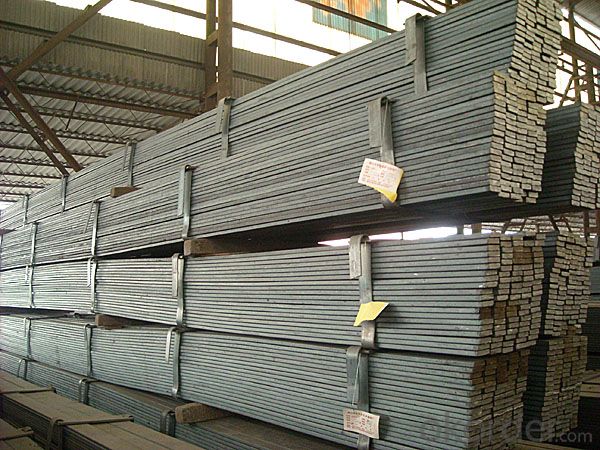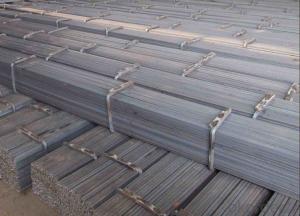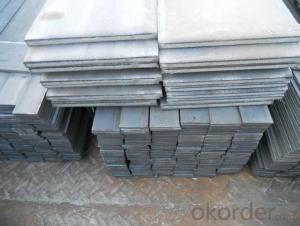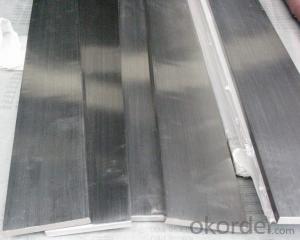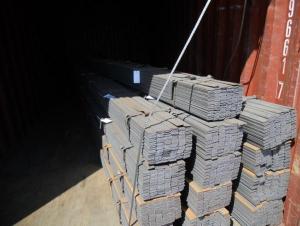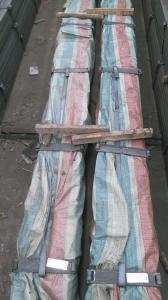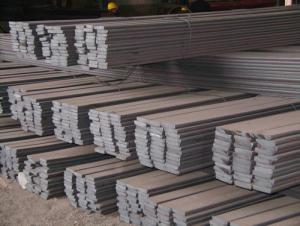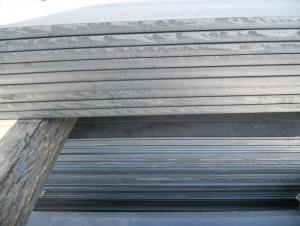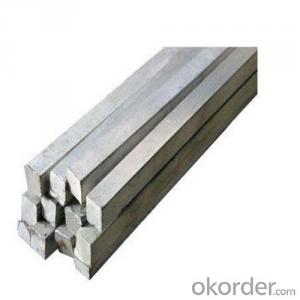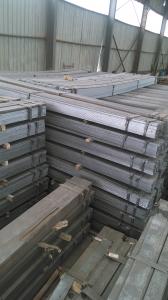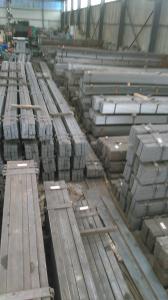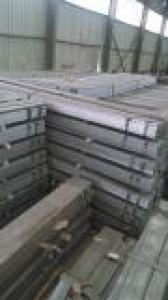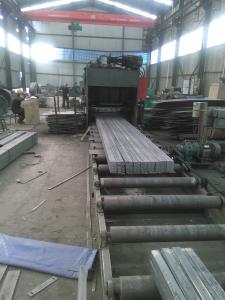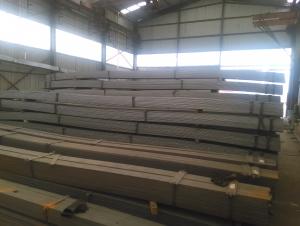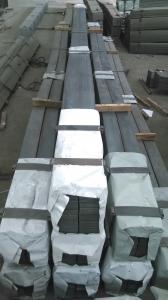Steel Flat Bar Chinese Standard Slit and Cut Form
- Loading Port:
- China main port
- Payment Terms:
- TT or LC
- Min Order Qty:
- 25 m.t.
- Supply Capability:
- 10000 m.t./month
OKorder Service Pledge
OKorder Financial Service
You Might Also Like
1. Structure of Steel Flat Bar Chinese Standard Slit and Cut Form Description:
Steel flat bar Chinese standard slit and cut form is a beam with an I-shaped cross-section. The horizontal elements of the "I" are known as flanges, while the vertical element is termed the "web". Steel flat bar Chinese standard slit and cut form is usually made of structural steel and is used in construction and civil engineering. The steel flat bar Chinese standard slit and cut form resists shear forces, while the flanges resist most of the bending moment experienced by the beam. Steel flat bar Chinese standard slit and cut form theory shows that the I-shaped section is a very efficient form for carrying both bending and shears loads in the plane of the web.
2. Main Features of Steel Flat Bar Chinese Standard Slit and Cut Form:
• Grade: Q235
• Type: Mild carbon steel
• Deflection: The stiffness of the I-beam will be chosen to minimize deformation
• Vibration: The stiffness and mass are chosen to prevent unacceptable vibrations, particularly in settings sensitive to vibrations, such as offices and libraries.
• Local yield: Caused by concentrated loads, such as at the beam's point of support.
3. Steel Flat Bar Chinese Standard Slit and Cut Form Images:
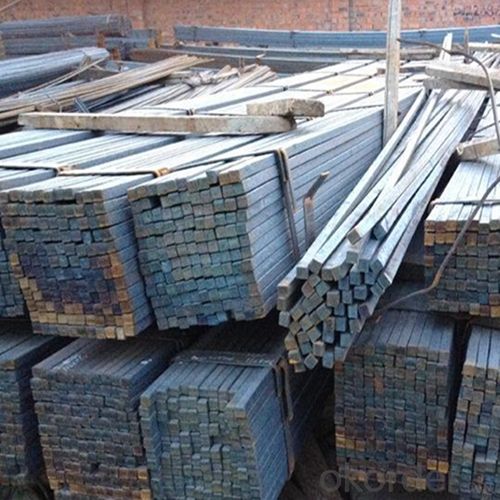
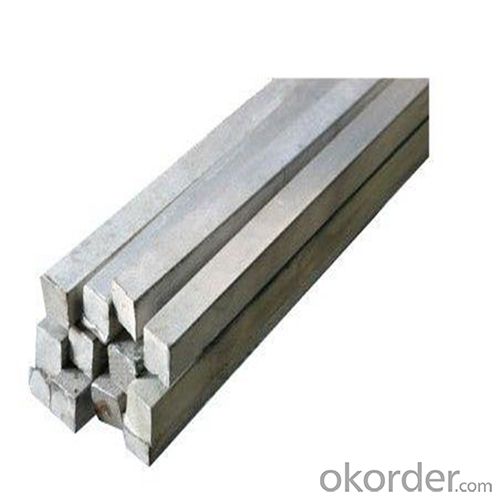
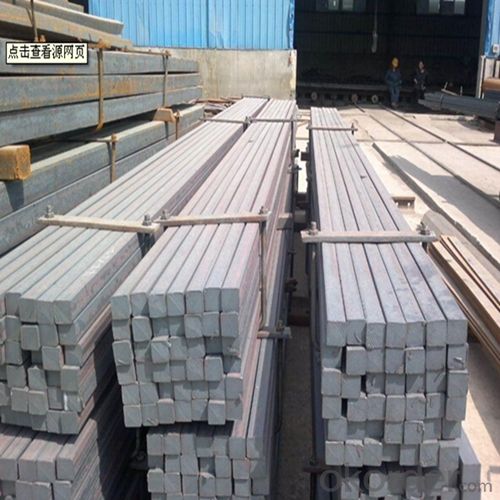
4. Steel Flat Bar Chinese Standard Slit and Cut Form Specification:
Alloy No | Grade | Element(%) | ||||
C
| Mn
| S
| P
| Si
| ||
Q235
|
B
|
0.12—0.20 |
0.3—0.7 |
≤0.045 |
≤0.045
|
≤0.3
|
Alloy No | Grade | Yielding strength point(Mpa) | Tensile strength (Mpa) | Elongation after fracture(%) | ||||||
Thickness (mm) | Thickness (mm) | |||||||||
≤16 | >16--40 | >40--60 | >60--100 | ≤16 | >16--40 | >40--60 | >60--100 | |||
≥ | ≥ | |||||||||
Q235 |
B |
235 |
225 |
215 |
205 |
375--500 |
26 |
25 |
24 |
23 |
5. FAQ
We have organized several common questions for our clients,may help you sincerely:
①Is this product same as W beam?
In the United States, the most commonly mentioned I-beam is the wide-flange (W) shape. These beams have flanges in which the planes are nearly parallel. Other I-beams include American Standard (designated S) shapes, in which flange surfaces are not parallel, and H-piles (designated HP), which are typically used as pile foundations. Wide-flange shapes are available in grade ASTM A992,[4] which has generally replaced the older ASTM grades A572 and A36.
②How to inspect the quality?
We have a professional inspection group which belongs to our company. We resolutely put an end to unqualified products flowing into the market. At the same time, we will provide necessary follow-up service assurance.
③Is there any advantage about this kind of product?
Steel I beam bar IPE has a reduced capacity in the transverse direction, and is also inefficient in carrying torsion, for which hollow structural sections are often preferred.
- Q: Are steel flat bars available in different surface coatings?
- Yes, steel flat bars are available in different surface coatings. These coatings are applied to enhance the durability, corrosion resistance, and aesthetic appearance of the steel bars. Common surface coatings for steel flat bars include galvanizing, which involves applying a layer of zinc to protect against rust and corrosion. Another popular coating is powder coating, where a dry powder is applied electrostatically and then cured under heat to form a hard and durable finish. Additionally, steel flat bars can also be coated with epoxy or enamel paints to provide additional protection and a desired color. The choice of surface coating depends on the specific application and desired properties of the steel flat bars.
- Q: Can steel flat bars be used for making brackets or supports for audio/video equipment?
- Yes, steel flat bars can be used for making brackets or supports for audio/video equipment. Steel is a durable and strong material, making it suitable for supporting heavy equipment. The flat shape of the bars allows for easy attachment to walls, ceilings, or other surfaces. Additionally, steel flat bars can be easily cut and shaped to fit the specific dimensions and requirements of the equipment. They provide stability and can withstand the weight and stress of audio/video equipment, ensuring safe and secure mounting.
- Q: Are steel flat bars suitable for handrail applications?
- Indeed, handrail applications can benefit from the use of steel flat bars. Not only are these bars robust and long-lasting, but they also offer an exceptional selection for handrails. They bring stability and support to the table, all the while providing a stylish and contemporary look. Moreover, the versatility of steel flat bars shines through, as they can be effortlessly tailored to suit a wide range of handrail designs. Painting or coating options are available to enhance their resistance to corrosion, ensuring they can withstand regular use and constant contact. In summary, steel flat bars present a dependable and economical choice for handrail applications.
- Q: Are steel flat bars available in different colors?
- Steel flat bars do not come in various colors, I'm afraid. Usually, steel is manufactured with its inherent grey hue due to its composition and production process. Nonetheless, it is feasible to alter the color of steel flat bars by applying diverse coatings or paint. These coatings can offer extra defense against rust or purely serve aesthetic intentions.
- Q: Are steel flat bars suitable for making agricultural equipment?
- Yes, steel flat bars are suitable for making agricultural equipment. Steel flat bars are known for their durability, strength, and versatility, making them an ideal material for various agricultural applications. They can be used to construct a wide range of equipment such as plows, cultivators, harrows, trailers, and livestock handling systems. Steel flat bars offer excellent structural integrity, allowing them to withstand the rigors of heavy-duty use in agricultural settings. Their high tensile strength makes them resistant to bending and breaking, ensuring long-lasting performance even under demanding conditions. Additionally, steel is highly resistant to corrosion, making it suitable for outdoor use and exposure to various weather conditions. Moreover, steel flat bars can easily be welded, cut, and shaped to meet specific design requirements, making them highly adaptable for manufacturing custom agricultural equipment. Their versatility allows for the creation of equipment that is tailored to the specific needs and preferences of farmers. In summary, steel flat bars are a reliable and suitable choice for making agricultural equipment due to their durability, strength, versatility, and resistance to corrosion.
- Q: What are the different types of surface coatings for steel flat bars?
- There are several different types of surface coatings available for steel flat bars, each with its unique properties and advantages. Some of the common types of surface coatings for steel flat bars include: 1. Galvanized Coating: This type of coating involves applying a layer of zinc to the surface of the steel flat bar. Galvanizing helps protect the steel from corrosion and rust, making it ideal for outdoor applications or areas with high humidity. 2. Powder Coating: Powder coating is a popular choice for steel flat bars as it provides a durable and attractive finish. In this process, a dry powder is electrostatically sprayed onto the surface of the steel flat bar, and then it is baked to create a hard, smooth coating. 3. Epoxy Coating: Epoxy coatings are known for their excellent adhesion and chemical resistance. They are often used in industrial settings where the steel flat bars are exposed to harsh chemicals or extreme weather conditions. 4. Paint Coating: Paint coatings are a versatile option for steel flat bars, allowing for customization in terms of color and finish. They provide a protective layer against corrosion and can be easily applied using spray or brush methods. 5. Chrome Plating: Chrome plating involves depositing a thin layer of chromium onto the surface of the steel flat bar. This coating provides excellent resistance to wear and corrosion, making it suitable for applications that require a high level of durability and aesthetics. 6. Black Oxide Coating: Black oxide coating is a chemical conversion coating that provides a black finish to the steel flat bar. It offers mild corrosion resistance and enhances the appearance of the steel flat bar. These are just a few examples of the different types of surface coatings available for steel flat bars. The choice of coating depends on the specific requirements of the application, such as the level of corrosion resistance, aesthetics, and environmental factors. It is important to consider the intended use and conditions to select the most appropriate coating for steel flat bars.
- Q: Building poles, outdoor flat steel, the deeper the buried depth, the better?
- The construction of outdoor flat steel at normal negative 1.5m or so, there is design requirements. Nor does it mean that the deeper the better. The main function of the outdoor ground flat steel is that when the lightning resistance of the main body of the building is not up to the design requirements, the artificial outdoor triangular steel pipe pile shall be added to the outdoor earthing flat steel until the ohm value is qualified. Normally, the outdoor ground flat steel does not work.
- Q: What is flat steel, please?
- Steel strip steel rectangular and with pure edge of cold drawn steel, stainless steel flat steel. Stainless steel flat can be semi-finished steel. There are cold drawn polished stainless steel flat and hot-rolled acid white and sand blasting stainless steel flat. The raw material for producing stainless steel flat bar is stainless steel square billet, and the finished stainless steel flat bar is produced by hot rolling, normalizing or hot rolling, pickling (or sand blasting), cold drawing and polishing. The two sides are equal in width. The specifications are expressed in millimeters of edge width * * edge thickness. Such as 30 * 3, that is, width of 30 mm edge, 3 mm thick edge of stainless steel flat side.
- Q: How do I store steel flat bars to prevent damage?
- To prevent damage to steel flat bars, it is recommended to store them in a dry and well-ventilated area, away from moisture and direct exposure to elements. You can stack them horizontally on a flat surface, ensuring they are properly supported and not overloaded. Using protective coverings, such as plastic or cardboard, between each layer can also help prevent scratches and other surface damage. Additionally, keeping them away from any corrosive materials and maintaining a consistent temperature can further protect the steel flat bars from damage.
- Q: Are steel flat bars suitable for welding projects?
- Yes, steel flat bars are suitable for welding projects. They have excellent weldability and can be easily joined together using various welding methods such as arc welding, MIG welding, or TIG welding. The flat shape of the bars also provides stability and ease of handling during the welding process.
Send your message to us
Steel Flat Bar Chinese Standard Slit and Cut Form
- Loading Port:
- China main port
- Payment Terms:
- TT or LC
- Min Order Qty:
- 25 m.t.
- Supply Capability:
- 10000 m.t./month
OKorder Service Pledge
OKorder Financial Service
Similar products
Hot products
Hot Searches
Related keywords


